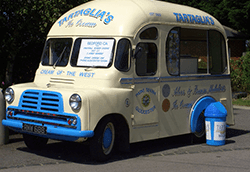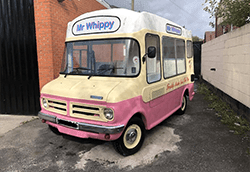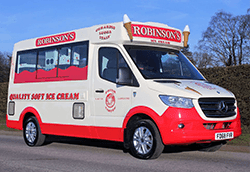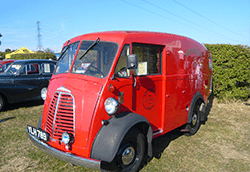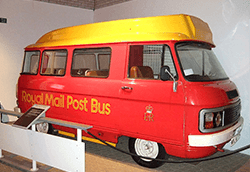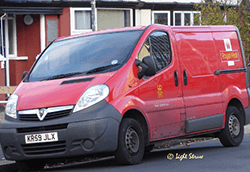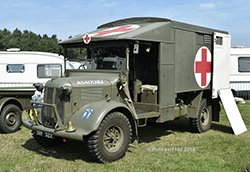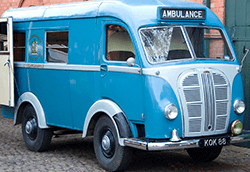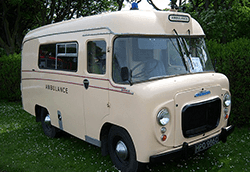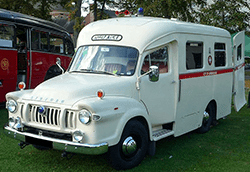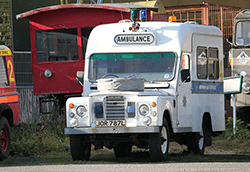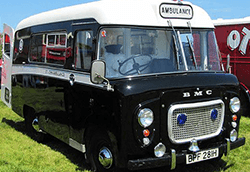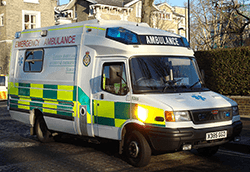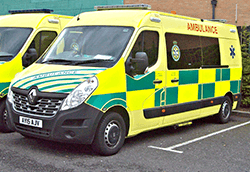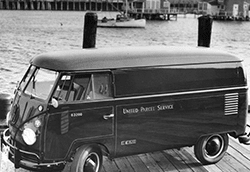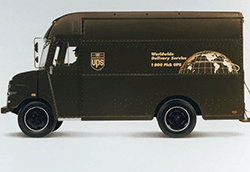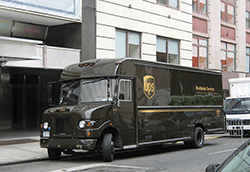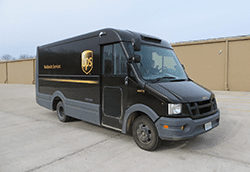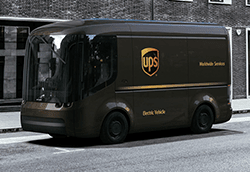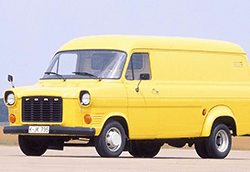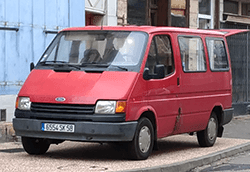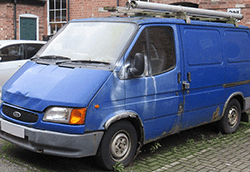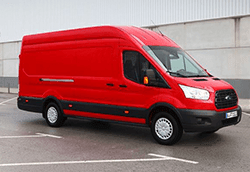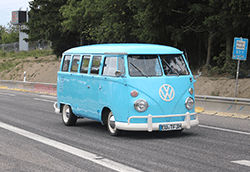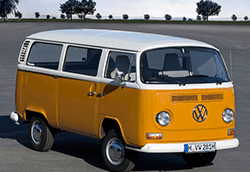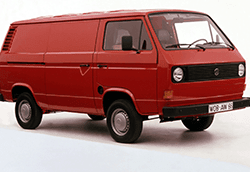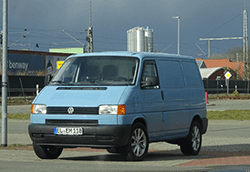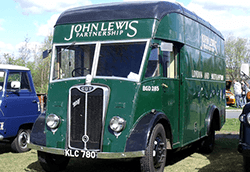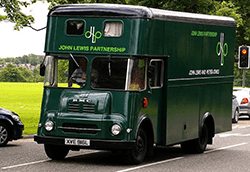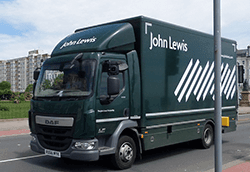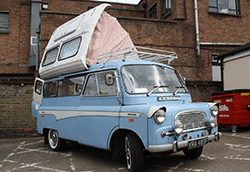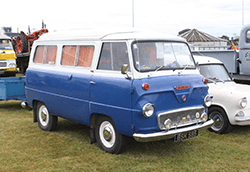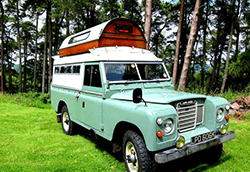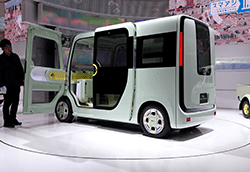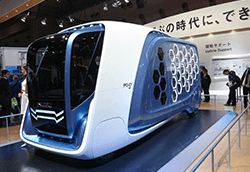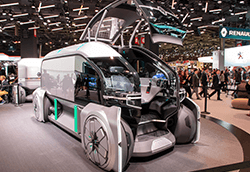

How have vans changed and how will they look in the future?
Just like some cars, a selection of vans have also reached iconic status. From the VW Camper to the trusty Transit, vans have played a part in all our lives. Whether it’s by helping us to move to a new house, taking us on holiday, or even serving us a cool treat on a warm day, vans have been part of some of our most memorable life moments. So it got us thinking, with so much history, how have vans changed over the years? We decided to look at some of the most popular and recognisable vans to ever grace our roads and take a trip down memory lane to find out exactly how the vans have changed.
Ice Cream Van
The most delicious van on our list, the ice cream van has had four iterations over the years. The first ice cream van in the UK was the Bedford CA in 1965. More than 30,000 were on our roads back in the 1960s as children and adults alike rejoiced at the chance to get an ice cream from the comfort of their front garden. By far the most familiar ice cream van, it is 1960s through and through. It was so popular that the second model, the Bedford CF, offered a modern twist whilst still keeping its heart.
The most widely recognised model, however, is probably the Ford Transit ice cream van which first served soft scoop back in 1995, taking over from the Bedford CF. The Transit boasted a lot of new tech which set it apart from the Bedford, and it can hold a huge 30 gallons of ice cream.
Despite the Transit being the most common, it’s not, in fact, the most recent ice cream van; that title sits with a Mercedes Sprinter. It was introduced as an ice cream van in 2013 and is starting to pop up around the country. On top of the chiller and freezer, the best piece of tech on the Sprinter from a driver’s point of view is the front and rear cameras, which helps with navigating around parks and narrow streets.
Royal Mail Van
Where would we be without the Royal Mail? Luckily for us, we don’t have to imagine a world without the symbolic red vans.
The first Royal Mail van was the Morris J Type and launched in 1957. Now immortalised in toy collections, the van is hugely recognisable and embodies the era perfectly. The most well-known quirk of the van is its opening windscreen, which is something that nowadays would never be allowed.
Seven models have come since the Morris, such as the Dodge Space Van and the Ford Fiesta Courier Kombi. Each time Royal Mail unveiled a new van, it represented the time it was released perfectly, and as such, each iteration is iconic in its own right.
The most common on roads today is the Fiat Doblo, which first sped onto roads in 2013. However, in the past few years Royal Mail has been focusing on reducing the emissions of its fleet. Last year, the company announced they would be adding 3,000 electric vans to its 300 electric fleet. One of their most recent trials include quadricycle class vehicles. This six-month trial focused on two electric vehicles around the size of a golf buggy - one with a range of 74 miles and one with 88 miles – to help with daily rounds.
Ambulance
The ambulance pre-dates the national health service by five years. The first ambulance was an Austin K2, more commonly referred to as ‘Katy’. It was a military ambulance that was used by Commonwealth services during the second world war. With its robust structure and a 3.5 litre engine, it was ideal for moving over unsteady land.
With the slogan, ‘You can depend on it’, the second ambulance model was the Austin K8 Welfarer which was relied upon for 16 years, until the Morris LD took over the service for just one year.
Modern ambulances need to be nimble enough to weave through heavy traffic, while carrying equipment for every eventuality, so it’s no surprise that the engine sizes increased. The current model, the Vauxhall Movano PTS, which has been on roads since 2015 is a 2.3CDTi, 6 speed van with enough power to respond to emergencies.
UPS van
In 63 years of the UPS van, there have been six models. The first of which was the icon that is the Volkswagen Econoline. It served UPS and its customers for a total of seven years until the most iconic van – the bubble front package car was adopted from 1965.
By the 1990s UPS needed an update, so the Grumman Olson/Navistar was introduced, offering a more modern mode of transport for delivery drivers. Until 2020, the company had settled on the Iveco Daily for four years, but since has adopted a greener mode of transport and switched to electric, much like the Royal Mail. You’re soon likely to see the Arrival Electric Van carrying parcels.
Ford Transit van
What would a list of all the vans be without mentioning the trusty Transit? A beacon of our roads since 1965, it hasn’t changed too much over the years, having had just three updates, the most recent of which was in 2013. It’s perhaps so popular thanks to its sizing options, making it perfect no matter what the usage.
Nowadays you can get a whole host of tech to help keep you company on long journeys, such as Bluetooth, USB ports and DAB radio.
VW Transporter
With six models, aptly named T1, T2, T3, T4, T5, and T6, the VW Transporter is another hugely recognisable van. Having been around since the 1950s, it even has a film named after it.
Starting shape as a camper, it is famed for being the preferred mode of transport for those heading to Woodstock and Glastonbury in the 1960s. Although its shape had changed slightly over the years, even the newer, squarer models from the third generation onwards retain their original charm.
Just like the Transit, the Transporter is flexible, with optional seats and windows in the back. So we’re not surprised it’s still a regular feature on our roads.
John Lewis
The John Lewis van is almost as symbolic as the store. Despite John Lewis delivering since 1949, there have only been three updates to the vans themselves. Originally operating with the Guy Wolf Furniture Van, John Lewis offered delivery way before it became the norm.
The second John Lewis delivery van came in the form of the DMC Delivery Truck in 1973, and switched to the DAF FA LF150 years later.
Motorhome
The last van we’re exploring is one many of us will have experience in – not of – the motorhome. Of course there are many different makes and models of motorhomes, but the earliest iconic model is the Bedford Dormobile. Released in the 1960s, it was manufactured in Kent and has an expanding roof, giving the owner more space when parked up. It came equipped with a gas stove and sink, cupboards and seats which converted into beds.
As motorhomes started to grow in popularity, they changed regularly with different shapes coming in and out of style. Now motorhomes come in a range of sizes, with awning add-ons, and full-sized beds, as well as fully kitted out kitchens and batteries that can power all kinds of tech for hours.
What does the future look like?
Companies face a shift in operations over the next decade as green targets get stricter. Whether it’s adapting to new ways of heating buildings, reducing single use plastics, or indeed switching from petrol and diesel vehicles to electric, the commercial logistics and transport world will look significantly different in the not-too-distant future.
We've already seen some electric vans take to the roads from the Royal Mail and UPS, to name a few, leading the way. Despite being fully functioning, many people mistake images of them to be concepts thanks to their futuristic design, with the USPS mail truck in America compared to Pixar animations.
They may look quirky at present, but this style of van will undoubtedly become a popular sight on roads as companies make the switch to full electric over the next decade.
We may not do motorhomes here at Northgate, but we do a lot of other vans, including the iconic Ford Transit 350.
So whether you’re after small van hire or lwb van hire, you can find what you’re looking for at one of our branches. Search for van hire near you using our directory, including van hire in Bolton.

This work is licensed under a Creative Commons Attribution-ShareAlike 4.0 International License.
- Ice cream van | Bedford CA | 1965 | Davestraintravels | SmugMug | https://davestraintravels.smugmug.com/Travel/Commercials/i-bZPNTZJ
- Ice cream van | Bedford CF | 1970 | ViaRETRO | https://viaretro.com/2019/12/prime-find-of-the-week-im-a-roadrunner-baby/1978-bedford-cf-ice-cream-van-1-2/
- Ice cream van | Ford Transit | 1995 | Neil Potter | Flickr | https://www.flickr.com/photos/151981482@N04/43928420821/
- Ice cream van | Mercedes Sprinter | 2013 | Whitby Morrison | Facebook | https://www.facebook.com/WhitbyMorrison/posts/-new-mondial-lusso-the-new-shape-mercedes-sprinter-just-looks-better-and-better-/10157392079500832/
- Royal Mail van | Morris J Type | 1957 | Triggerscarstuff | Flickr | https://www.flickr.com/photos/triggerscarstuff/3964229680/
- Royal Mail van | Dodge Space Van | 1967 | Wikimedia | https://commons.wikimedia.org/wiki/File:Postbus_Dodge_Spacevan_2090P_(1983).jpg
- Royal Mail van | Austin Morris J4 | 1973 | Shaun Ballisat | Flickr | https://www.flickr.com/photos/41056391@N05/15667472145
- Royal Mail van | Bedford Midi Postbus | 1990 | Mr Sandtoft. | Flickr | https://www.flickr.com/photos/carley1961/39554039874
- Royal Mail van | Ford Fiesta Courier Kombi | 2000 | Steve Knight | Flickr | https://www.flickr.com/photos/kitmasterbloke/18618092246
- Royal Mail van | Vauxhall Vivaro | 2009 | Light Straw | http://www.lightstraw.co.uk/gpo/do/rm/vivaro1.html
- Royal Mail van | Fiat Doblo | 2013 | Light Straw | http://www.lightstraw.co.uk/gpo/do/rm/doblo1.html
- Ambulance | Austin K2 Ambulance ‘Katy’ | 1943 | policest1100 | Flickr | https://www.flickr.com/photos/83194815@N00/49195497807
- Ambulance | Austin K8 `Welfarer` | 1949 | David Busfield | Flickr | https://www.flickr.com/photos/buzzer999/8108112721
- Ambulance | Morris LD | 1965 | Wikimedia | https://commons.wikimedia.org/wiki/File:1965_Morris_LD_Wadham_Stringer_(HPO_986C)_ambulance,_2012_HCVS_Tyne-Tees_Run.jpg
- Ambulance | Bedford J1 | 1966 | Wikipedia | https://en.wikipedia.org/wiki/File:Bedford_J1_Ambulance_1966.jpg
- Ambulance | Land Rover Series 3 | 1970 | Wikimedia | https://commons.wikimedia.org/wiki/File:Land_Rover_Ambulance_(7945877448).jpg
- Ambulance | BMC | 1970 | Whitehaven and Western Lakeland | http://www.whitehavenandwesternlakeland.co.uk/vintage2011/commercial.htm
- Ambulance | Ford Transit M2 | 1984 | rwcar4 | Flickr | https://www.flickr.com/photos/45703383@N05/40618113305
- Ambulance | LDV Ambulance | 2000 | Wikipedia | https://en.wikipedia.org/wiki/LDV_Convoy#/media/File:London_Ambulance_on_Hamilton_Terrace.jpg
- Ambulance | Vauxhall Movano PTS | 2015 | Robert Knight | Flickr | https://www.flickr.com/photos/45676495@N05/42693169271
- UPS van | Volkswagen Econoline Van | 1958 | Huffington Post | https://www.huffingtonpost.co.uk/entry/old-ups-delivery-truck-photos_n_5584562?ri18n=true
- UPS van | 'Bubble front' design first launched - no make/model specified | 1965 | UPS | Twitter | https://twitter.com/UPS/status/1033036243498496000/photo/1
- UPS van | Grumman Olson/Navistar | 1990 | Wikipedia | https://en.wikipedia.org/wiki/United_Parcel_Service#/media/File:UPS_truck_(3550005149).jpg
- UPS van | Isuzu Reach Utilimaster Van | - | m.yamnitz | Flickr | https://www.flickr.com/photos/12602543@N08/15710634183
- UPS van | Iveco Daily | 2016 | Carsbusestrainsandtrucks | Flickr | https://www.flickr.com/photos/151350615@N03/36678474615/
- UPS van | Arrival Electric Van | 2020 | Autocar | https://www.autocar.co.uk/car-news/industry/ups-orders-10000-electric-vans-british-start-arrival
- Ford Transit van | First generation | 1965 | motor1 | https://www.motor1.com/photo/2249560/first-generation-ford-transit/
- Ford Transit van | Second generation | 1986 | Wikimedia | https://commons.wikimedia.org/wiki/File:Ford_Transit_1986.jpg
- Ford Transit van | Third generation | 2000 | Wikimedia | https://commons.wikimedia.org/wiki/File:2000_Ford_Transit_120_SWB_2.5.jpg
- Ford Transit van | Fourth generation | 2013 | Honest John | https://vans.honestjohn.co.uk/van-reviews/ford/transit-2014/
- VW Transporter | T1 | 1950 | 100Watt-Birne | Flickr | https://www.flickr.com/photos/131372462@N07/50418975917/in/photolist-2jPmqYe-2jTZLJj-2hcikPL-2he57wn-TtiDJX-xxCsfb-2iBDTFP-2kV5SPh-CnSENq-2eqBy3X-2kj8u1Q-R3m5FF-LXJbPF-DpevWM-2cYvf8h-2dnYsH6-LgeM3D-SZC1t4-2hF4SJV-2hHH8tZ-2ixRf6j-23nkG6b-m1JyZM-HopC1C-2iYQS2e-2kSQBQR-pGWvki-RDJ3KV-24Cg1rc-m1HSBT-2j4VvS5-Rbsx3j-2kRWN6t-2cyJB5W-FfEyFs-2kRM1J1-XGaTmk-2iV2VJu-QQqHaW-npEiWR-Wr5PoG-2jQzptJ-2jrEe8h-26NKVwD-pZq6Hw-Qb6Dvv-TghzEq-SU3gdv-WiKRpb-9E5pJ1
- VW Transporter | T2 | 1967 | motor1 | https://www.motor1.com/news/406416/volkswagen-transporter-turns-70/
- VW Transporter | T3 | 1979 | FavCars | https://www.favcars.com/photos-volkswagen-t3-transporter-van-1979-92-2383.htm
- VW Transporter | T4 | 1990 | Peterolthof | Flickr | https://www.flickr.com/photos/peterolthof/51100558774/in/photolist-2kRzHNN-2hxLAgX-2jn1bm3-2hpvo5p-2kB51Rh-2juczQV-2kW2cux-2kfvoBT-2juczTf-2kUBGSE-yGzvLA-2kL9LqP-S5h5PJ-SArH5s-2j4qFpd-2gjC8HE-2aFoFMT-26gtfgE-4YEo7H-4YEhMF-4YJB21-4YJxAf-4YJAGu-4YJzgj-4YJzRN-EVMM8k-4YEhsR-4YJxWw-4YEg7Z-4YEfyD-4YEeKR-4YJA8Y-4YEjBz-4YEiGe-YS4otL-4YJCS7-4YJyWS-4YJwGj-2i2mbE8-4YJDvu-4YEfir-4YEf3X-4YEmM2-4YJxh3-4YEkS8-4YEmrk-4YEnqr-4YEmak-4YJBmJ-2kRXcYN
- John Lewis van | Guy Wolf furniture van | 1949 | Damian Sharples | Flickr | https://www.flickr.com/photos/48950471@N02/6947908312/in/photolist-bzXR5C-2jt6c99-YWujDE-2jndMK1-ZL18N7-7Ki7cQ-ZNGn1M-YH5iRU-CAGw9o-U2UD2W-CKdzb7-ZM5K6N-ZQkPYz-6vUDis-3Hqv15-8GkDwR-ZWgp47-XHFUuQ-6ue1b6-2ipRhVQ-6uawZJ-oKjT2h-25UFNqb-26xpLXu-KMhJMa-Hn3mGS-2j5NZbW-2jhrH64-FYCcsZ-2129QTM-G5zsg6-ZWgJ15-9ykG9f-35rA9b-9FPjR3-axyQ3S-P68WPh-2b9v4zN-26dy8Z8-V9M73G-YqKsMc-2ipRhUc-2kgnrb9-87TEbA-2ipLsnr-FQHnva-EMggu6-2ijK8ZF-2kXrt5z-2kTHc83
- John Lewis van | BMC delivery truck | 1973 | Mike Earley | Pinterest | https://www.pinterest.co.uk/pin/298082069079608178/
- John Lewis van | DAF FA LF150 | | Pjlcsmith2 | Flickr | https://www.flickr.com/photos/16684904@N02/34713005371/in/photolist-UTte7B-2gZxdjT-CCE77Y-ZH5E4b-ZKC5vy-YXnmew-ZMCiBN-CAFrYw-25SUfQT-pepvp4-bzXR5C-2jt6c99-YWujDE-2jndMK1-ZL18N7-7Ki7cQ-ZNGn1M-YH5iRU-CAGw9o-U2UD2W-CKdzb7-ZM5K6N-ZQkPYz-6vUDis-3Hqv15-8GkDwR-ZWgp47-XHFUuQ-6ue1b6-2ipRhVQ-6uawZJ-oKjT2h-25UFNqb-26xpLXu-KMhJMa-Hn3mGS-2j5NZbW-2jhrH64-FYCcsZ-2129QTM-G5zsg6-ZWgJ15-9ykG9f-35rA9b-9FPjR3-axyQ3S-P68WPh-2b9v4zN-26dy8Z8-V9M73G
- Campervans/motorhomes | Bedford Dormobile | 1960 | Pentakrom | Flickr | https://www.flickr.com/photos/59455242@N07/46545852652/in/photolist-2dV6EmU-28hNW24-2jf4KC6-eYYJ8B-2jxyuXY-uUaSp9-24T68fu-7wnLvv-eUyazc-2afDMgi-3je5uW-2gJwbgn-28Sx5je-2hxRDBJ-6z6zWe-Sh4gKy-74wscN-2fknUaa-Kd19eF-2kDukUh-6eJfxz-WbSKWm-pSv1a9-cvdpDU-cvdurG-5a7RXi-5tHCXC-5tDgrv-5ko1Gg-6MESE2-cvdreG-FhHv2z-6z6zYV-2k1mhAS-5est45-7M2Wq1-5kshSG-cvdsUw-9zneci-2kvedFT-tMgMR3-2kAbxez-dSVWXc-d7CSQE-2jHhxCV-2hLC1jk-PKgP8Y-2g8dR6P-2jJYJrd-No3TrD
- Campervans/motorhomes | Ford Thames 400E | | Alister Anderson | Flickr | https://www.flickr.com/photos/116780863@N05/16416699645/in/photolist-r1FSRB-dEL4Cw-e7CXnb-276fP93-odrXqZ-5zuMbe-sqDnR2-H7cFKf-YqBLvs-g5Mz9K-ajq9pa-bcT98n-cW5X3o-2kYJD2x-z9PfSR-2g4mKU4-vm7T6Z-vkAqPh-J1jV1X-pHRGHb-7ZSKZZ-23VvY2r-PktjJG-9vrQ8X-2iyKp6D-27HJCGB-mMg2mk-HJNwVp-wW16aL-Jm7nzL-uzoSsR-2k8FaJa-6ugQtx-nJWn9F-bwLu3A-dR3PYg-27idSEo-TcwL8A-27D84og-2dLjhmi-nskerq-28npwPP-2hu2yQ5-8sPzGs-irAh2Z-eFzwhg-pU3Bb6-2gmA9bu-nAbnsc-L9h2zB
- Campervans/motorhomes | Landrover Carawagon | 1972 | Land Rover Centre Huddersfield | https://www.landrovercentre.com/product/lpd606k/
- Campervans/motorhomes | Holdsworth Rainbow | 1993 | Dragonville Leisure | https://www.dvleisure.com/?id=806006
- Campervans/motorhomes | Swift Mondial Grand Tourer | 2000 | Dragonville Leisure | https://www.dvleisure.com/?id=763345
- Campervans/motorhomes | Peugeot Autosleeper Warwick XL | 2016 | Simpsons Motorhomes | https://simpsonsmotorhomes.co.uk/new-motorhomes/peugeot-auto-sleeper-warwick-xl
